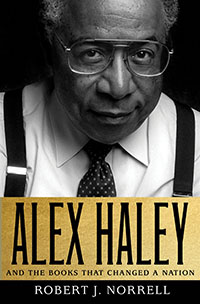Myths to Live By
Robert Norrell tells the story of Alex Haley, whose books shaped the way we think about black history and culture
The Autobiography of Malcolm X enshrined its protagonist’s place in American history. Roots stimulated a massive appreciation for the African-American past, from the heritage of Africa through the trials of slavery. The stories in these books reached ever-wider audiences through movies and television. Their common thread is Alex Haley, who collaborated with Malcolm X and then wrote about his own ancestors in an epic saga. In Alex Haley and the Books That Changed a Nation, Robert Norrell recovers the extraordinary tale of the author and his monumental, controversy-laden bestsellers.
 A distinguished historian of African-American life at the University of Tennessee-Knoxville, Norrell sheds light on the avuncular, gifted storyteller who struggled to achieve professional success. “Haley wrote the two most important works in black culture in the twentieth century,” argues Norrell. “More than any other writer, he changed the way the masses of Americans understood the black experience. He gave whites a compelling reminder of the ugliness of racial exploitation and blacks a sense of ownership of their past, with all its travails but also its triumphs.”
A distinguished historian of African-American life at the University of Tennessee-Knoxville, Norrell sheds light on the avuncular, gifted storyteller who struggled to achieve professional success. “Haley wrote the two most important works in black culture in the twentieth century,” argues Norrell. “More than any other writer, he changed the way the masses of Americans understood the black experience. He gave whites a compelling reminder of the ugliness of racial exploitation and blacks a sense of ownership of their past, with all its travails but also its triumphs.”
Haley romanticized his childhood in rural Henning, Tennessee, but he actually spent much of his early life at a variety of poor black colleges. His father, a professor, urged him to become a college-educated “scientific farmer,” but during World War II, Haley joined the Coast Guard as a mess boy. From this unlikely spot, he launched a writing career. To stave off boredom, he wrote letters. Then he wrote letters for his shipmates. Then he started publishing the ship’s newspaper. After the war, he re-enlisted and in 1949 became the first Chief Journalist for the Coast Guard.
Haley tried to break into magazine writing, though with limited success. In the 1960s, he wrote some feel-good profiles of black stars such as Wilma Rudolph and Mahalia Jackson, but his breakthrough arrived with articles about the Nation of Islam in Reader’s Digest and The Saturday Evening Post>, followed by a Playboy interview with Malcolm X. Haley was neither a black nationalist nor an apologist. He explained the alienation that drove many blacks to the doctrine of a separatist group, and he called for amelioration of “the Negroes’ honest grievances.”
His partnership with Malcolm X resulted in one of the seminal documents in African-American history. In their early interviews, Malcolm X just spouted dogma. Then Haley asked him about his mother. The tone changed, opening the window for what became the affecting early chapters of the book. Haley conducted the interviews from 1963 through 1965, as Malcolm X reached his greatest fame, was exiled from the Nation of Islam, traveled to Africa and the Middle East, and was assassinated. The Autobiography of Malcolm X followed that sensational arc: its protagonist narrated his intellectual evolution as it happened, and Haley’s epilogue explained Malcolm X’s demise and influence.
Some critics accused Haley of exaggerating Malcolm X’s turn from black separatism, and others place the book in a broader American autobiographical tradition that moves “from ignorance to enlightenment.” Indeed, these qualities help explain why more than two million copies sold by 1969. But the subject was so controversial that the original publisher, Doubleday, canceled its contract days after the assassination. As Norrell writes, “The Autobiography of Malcolm X was a statement of black anger and a rationale for an aggressive response to the historic mistreatment of African Americans.” Haley’s book forged an icon of black pride and manhood.
 Haley’s next project was his family’s history. “Actually my story is much more than the story of one family,” he proclaimed. “In effect, I have charted the history of every black American. I say this because every one of us is directly descended from some African who was taken from his homeland, dragged to America, chained in the hold of a ship, and callously sold as a slave.” To the frustration of his agent and publishers, though, Haley was exceptionally slow to deliver a manuscript. In debt to the IRS—due in part to his extensive research trips to Washington, London, Ireland, and Gambia—Haley kept pitching other projects, trying to drum up advance money. He struggled to put pen to page.
Haley’s next project was his family’s history. “Actually my story is much more than the story of one family,” he proclaimed. “In effect, I have charted the history of every black American. I say this because every one of us is directly descended from some African who was taken from his homeland, dragged to America, chained in the hold of a ship, and callously sold as a slave.” To the frustration of his agent and publishers, though, Haley was exceptionally slow to deliver a manuscript. In debt to the IRS—due in part to his extensive research trips to Washington, London, Ireland, and Gambia—Haley kept pitching other projects, trying to drum up advance money. He struggled to put pen to page.
Roots was finally published in 1976 to great popular acclaim. In the decade since the Autobiography, the Black-Power movement had inspired pride in black history and culture, and scholars had recovered Africa as a legitimate subject of study. Haley’s book fashioned an idyllic vision of West Africa, and its hero, Kunta Kinte, was proud, courageous, and resilient. Strong black men protected the family through the horrors of slavery. As Norrell notes, previous popular epics of slavery had captured public fascination, from Uncle Tom’s Cabin to Gone with the Wind. But Roots was a “complete revision” of stereotyped black life involving happy slaves or sassy mammies. It chronicled fully fleshed characters persevering within a cruel, violent system.
The eight-part television miniseries Roots, debuted in 1977 and was a ratings bonanza. Unlike the book, it focused more on American slavery than on West Africa, but it compelled a deeper appreciation of African-American history, among both blacks and liberal whites. About eighty-five percent of American households watched at least one episode. Its success spawned new fame for Haley, as well as a follow-up miniseries titled Roots: The Next Generation. For a brief moment, Norrell writes, Haley was “the biggest celebrity in the United States.”
But he soon faced problems, including multiple lawsuits for copyright infringement. He deflected most of them, though he clearly borrowed the language in some passages from Harold Courlander’s The African, a case he settled out of court. Other problems arose because Roots had been marketed as nonfiction, despite its use of imaginative devices such as dialogue. Journalists and historians revealed serious problems with Haley’s evidence and pointed out other inaccuracies—including, most notably, the unlikelihood that white Europeans had seized black slaves from the upper Gambia River in 1767, the foundation for the Roots saga. Haley was embittered by the lawsuits and criticisms, feeling that the work of black authors received unfair scrutiny.
In this crisp and intelligent book, Norrell acknowledges Haley’s mistakes, but he also celebrates the author’s major contributions to African-American culture. Haley, he points out, was providing a real service in trying to build up African Americans, to give them strength and pride. As Haley himself wrote, “I was just trying to give them a myth to live by.”

Aram Goudsouzian chairs the history department at the University of Memphis. His most recent book is Down to the Crossroads: Civil Rights, Black Power, and the Meredith March Against Fear.


